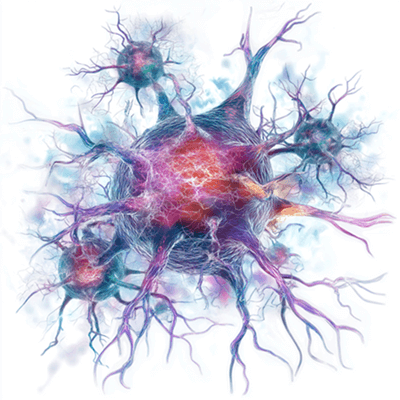Possible Causes
Immune Cells – Friend or Foe?

While most pain research focuses on the neurons, keep in mind they are just the conduit that transmit signals. The glial cells (part of the immune system) might be viewed as the brains of the operation, particularly in fibromyalgia. These highly evolved cells are tasked with keeping the neurons healthy and functioning properly. Whenever your glial cells get a whiff of injury, disease, or another threat to your neuronal circuits, they rectify the situation … and pronto!
If a virus invades your body, the glial cells become activated and pump out viral-killing chemicals to eliminate the threat. Although these chemicals are toxic to the neurons, the situation is short-term and necessary for the survival. Once the virus is destroyed and the neurons are nurtured back to health, the glial cells turn mellow again.
In their mellow state, glial cells are always on the lookout for evidence of neuron malfunctions. In fact, when neurons are injured or overly activated, they send out “find me” signals to the glial cells. The glial cells rush to the site to engulf and remove injured cells. And, if the neurons are hyperactive, the glia surround the overworked neurons to get them to chill out (sort of like snuffing out a fire).
Within the CNS there are two main types of glia: microglia and astrocytes. If you think of these two cells as the neuron’s parents, the microglia play a more disciplinary role while the astrocytes are nurturing. But all in all, they work as a team and their functions overlap.
Your Glia in Action
![]()
The microglia move rapidly to the site of dying neurons or those that are injured. They prune and dissolve the nonfunctional portions, remove associated debris, and help the neurons heal. When neurotransmitter levels get out of hand (such as substance P and glutamate), it’s a sign of hyperactive neurons. The microglia isolate them (like putting the neurons in timeout) until they calm down.
The astrocytes play a key role in providing nutrients for your neurons, especially energy, as well as pulling glutamate out of the synapse. High glutamate levels are toxic to the neurons and if it persists for too long, it can trigger “cell death” signals. In fact, the astrocytes are the CNS cells responsible for maintaining a healthy glutamate/GABA balance. They also regulate brain blood flow.
Wait a minute. If the glial cells were doing their job, your CNS neurons would be calmly conveying information and the transmitter concentrations would be in the normal range. Given the elevated concentrations of substance P and glutamate in fibromyalgia, could your glial cells have gone rouge and are now your neurons’ foe? It’s a strong possibility.
Brain imaging studies show fibromyalgia patients have chronically activated glial cells throughout their brains (both microglia and astrocytes). Also, the degree of activation, or what researchers call neuroinflammation, correlates with severity of pain, fatigue, and reduced physical function.
Commonly known triggers for initiating fibromyalgia can activate your glial cells (infection, trauma, stress, etc.). In addition, high levels of pain amplifiers (e.g., glutamate and substance P) will also agitate the glia. However, why they remain “turned on” is probably tied to genetics. All in all, it appears that the glial cells are just as guilty as the neurons for causing fibromyalgia symptoms.
What You Can Do
What can be done about activated glial cells? Naltrexone quiets them down (both the microglia and the astrocytes), but it also blocks the body’s opioid receptors. Therefore, low-dose naltrexone (LDN) is prescribed (typically 4.5 mg/day). Glial cells are easily activated by stress, so relieving stress will also work to reduce fibromyalgia symptoms. This includes gentle exercise, brisk walks, and forms of yoga that include relaxation breathing. In addition, a good night’s sleep is a great stressbuster.
If you are not familiar with LDN, AFSA funded a clinical trial showing it benefits about one-third of fibromyalgia patients. See our articles on How the Drug Works and Giving LDN Your Best Shot (offers treatment advice from four experts). AFSA also funded a study documenting neuroinflammation (microglia activation) in the brains of fibromyalgia patients.
Stay Current on Treatments & Research News: Sign up for a Free Membership today!
Why So Many Symptoms | Neutrophils & Fibro | Chaos in Brain | Managing Pain | Medications
References for Glial Cells & Fibromyalgia
- Matejuk A, Ransohoff RM. Front Immunol 11:1461, 2020. Free Report
- Wang T, et al. Cells 12(19):2336, 2023. Free Report
- Schousboe A, et al. Adv Neurobiol 11:13-30, 2014. Free Report
Back To Central Nervous System Causes
